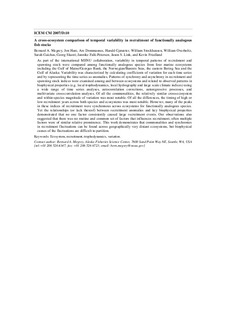| dc.description.abstract | As part of the international MENU collaboration, variability in temporal patterns of recruitment and
spawning stock were compared among functionally analogous species from four marine ecosystems
including the Gulf of Maine/Georges Bank, the Norwegian/Barents Seas, the eastern Bering Sea and the
Gulf of Alaska. Variability was characterized by calculating coefficients of variation for each time series
and by representing the time series as anomalies. Patterns of synchrony and asynchrony in recruitment and
spawning stock indices were examined among and between ecosystems and related to observed patterns in
biophysical properties (e.g. local trophodynamics, local hydrography and large scale climate indices) using
a wide range of time series analyses, autocorrelation corrections, autoregressive processes, and
multivariate cross-correlation analyses. Of all the commonalities, the relatively similar cross-ecosystem
and within-species magnitude of variation was most notable. Of all the differences, the timing of high or
low recruitment years across both species and ecosystems was most notable. However, many of the peaks
in these indices of recruitment were synchronous across ecosystems for functionally analogous species.
Yet the relationships (or lack thereof) between recruitment anomalies and key biophysical properties
demonstrated that no one factor consistently caused large recruitment events. Our observations also
suggested that there was no routine and common set of factors that influences recruitment; often multiple
factors were of similar relative prominence. This work demonstrates that commonalities and synchronies
in recruitment fluctuations can be found across geographically very distant ecosystems, but biophysical
causes of the fluctuations are difficult to partition.
Keywords: Ecosystem, recruitment, trophodynamics, variation. | no_NO |
